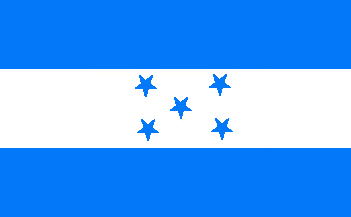
by Jaume Ollé'

Last modified: 2021-08-25 by rob raeside
Keywords: honduras | united states of central america |
Links: FOTW homepage |
search |
disclaimer and copyright |
write us |
mirrors
See also :
Michel Lupant made a review on the flag of Honduras in Vexilla
Belgica 1985. [Seems that Jaume only knows Michel's original
article and not the very long corrections to that article].
Acording to this article, Honduras used the federal flag from
1823 to 1825. On 3 October1825, it established its own arms, but
it is not quoted if this arms were used on the federal flag
instead of the federal arms, below the federal arms as in Costa
Rica, or were not used at all (at least until after 1839). In
1839 the federation was disolved but Honduras continue to use the
federal flag (with the Honduras arms, I assume). On 2 April 1851
a new federation was established and the federal flag was B-W-B
with new arms in center. But as this federation was disolved in
few months, it can be suposed that the previous flags stay in
use.
On 16 February 1866, decree 7 created the first national flag -
The commercial flag which was of 3 or 4 "aunes" long
and 9 pouces wide. Accoding to image from the book of Prof.
Braganza the ratio was 3:8. [Jaume did read Michel's article,
but he did not read the long follow-up article which corrected
all the errors. If Jaume's measures were correct the flag would
have been 2,5 or 3,3 m long and 21 cm high! The names of the
measures are different and the text is different in all! Each
stripe of the flag is 3 to 4 varas long and 9 pulgadas wide. So
the flag is 27 pulgadas wide! ]
The 5 blue five-pointed stars were pictured as following:
a) By Braganza - semicircle from above to below (Reference:
Prof. J. Alfonso Braganza: La Bandera, representacion simbolica
de la Nación Hondureña, su historia. Min. de Educación
Publica, Departamento de recursos de Aprendizaje, sección de
producción de materiales educativos, Tegucigalpa 1982)
b) By Admiralty Flags - as in the present flags (Drawings
of the flag in use at the present time by various nations,
Admiralty, London, August 1889, p. 64) .
There was also a war flag and ensign: the national flag with the
arms in the center in "Admiralty flags". The arms are
not the one adopted in 1825 but differents (Was also adopted in
1866?).
In June 1895, there was a new attempt of federation and the flag
of 1851 was readopted with slighty changed arms, but in November
1898 it was disolved, and the old flags were in use again. In
fact I believe that they didn't disapear at all.
The war flag and ensign were perhaps changed around this years
.In 1905 Flaggenbuch published the war flag and ensign bearing
the arms in the center and the stars in semicircle below the
arms. This image is same as in National Geographic Magazime flag
issue 1917 (probably NGM was based in Flaggenbuch). The commerce
ensign is as previousely, with 5 stars in both sources.
On 1906, it was promulgated a military ordinance and the military
flag was described. There are some mistakes in the description.
The flag is descirbed as square (but acccording Braganza was used
in proportion 5:6) 1.40 m. with three stripes, in the white
stripe embrodoined the national arms in a size of 50 cm. high and
40 cm. long (that is impossible because the white stripe is less
than 50 cm.). In the upper blue stripe embrodoined in gold
REPUBLICA DE HONDURAS and below BATALLON DE .... the size is 71
mm. high (Both in semicricle). In the lower stripe was the city
name were the battallion has its hedquarters, also in semicircle
(inverse that the previous) and gold embrodoined (same size)
In this ordinance alsowas established the state flag (bandera
nacional) with proportion 45:25, but is not quoted in the law if
is only blue, white and blue or must bear the stars or the arms.
On 27 September 1933, a resolution numbered 194 established what
must be the national flag on the education buildings. The
proprotion must be 3 aunes x 20 pouces (inches? - this seems to
be c. 3:8) bearing in the central white band, in semicircle, 5
blue five pointed stars, and then above (upper stripe) the
college name and below (lower stripe) the city, both in
secicircle (inverese one from other). A drawing attached to this
resolution show the stars as in the present flags even if the
text contradict the drawing. [Here Jaume is completely wrong.
Again the measures originally given are "varas" and
"pulgadas" and not aunes and pouces. 1 vara was (only
in Central America!) 83,6 cm, 1 pulgada (or thumb) was 2,33 cm.
So it is not 3:8 but very different! The illustration should be
the first one mentioned by Jaume. Both illustrations are
interchanged!]
The national arms were adopted by Decree dated 10 January 1935
The national flag was finally established by decree 18 Junaury
1949, that revised the legislation dated 1866. Proportion is 1:2.
The five stars must be: 4 forming a rectangle and the last one
(5th) in the center of this rectangle. The war flag and ensign
bear the arms in the center and below 5 stars in semicircle
inverse. The five stars represent the 5 countries: central one to
Honduras, upper hoist, Guatemala, upper fly Nicaragua; lower
hoist, El Salvador; lower fly Costa Rica. The color is described
as "azul turquesa" that mean light blue, but this was a
mistake and the correct name was "azul turqui"
that mean dark blue, that is the color used already before 1949.[
What colour is azul turquesa and what shade is azul turqui?
There was no mistake! The colour is named in the decree:
"...la superior y la inferior de color azul turquesa
(turqui)...". So turqui is not a correction but an alternate
name; it is in brackets behind the name since the original
decree. Ask a printer in Spain what colour azul turquesa or
turquis is and he will show you a special colour: Cyan. The
colour shade of the Honduran flag was always, at least by law,
light blue. Misunderstanding of colour names and shades produced
such legal errors. The discussion of red - purple - violet is
only one field of misunderstandings. The blues are another one!
In 1949 the flag was changed due to the misproportions of the
flag. The new proportions were fixed at 1:2. And again the colour
is named "azul turquesa (turqui)"].
Jaume Ollé [notes in brackets by Ralf Stelter, 2
June 2004], 18 November 2003
Adopted: 16 February 1866 Abolished: de-facto between 1910 and
1939; the date reported by W. Crampton, 18 January 1949, can be
the just official date.
Jaume Ollé'
1) 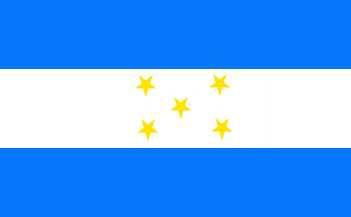
National Flag
by Jaume Ollé'
2) 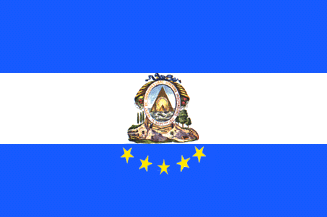
Naval Ensign
by Jaume Ollé'
The 1895 flag of Honduras is the one shown in Ruhls flagchart!
The laws and descriptions of the flags were never changed after
1866! Although there were some publications with interchanged
flags and text, so that some might have found new flags.
Ralf Stelter, 7 November 2000
In 1895 Honduras was part of the Republica
Mayor de Centroamerica that adopted its own flag . It was
short lived and the old flag was back in use. However, since the
stars in the flag of the Republica Mayor were gold, flags were
frequently manufactured with gold stars. This flag with gold
stars (in use after c. 1896) is shown in Flaggenbuch 1905
Jaume Ollé, 11 November 2000
The Honduran flag with golden stars was a misprint, it was the publisher's
fault. This was told to me by Dr. Otfried Neubecker who helped me to build up my
Archiv für Flaggenkunde.
Ralf Stelter, 01 March 2014
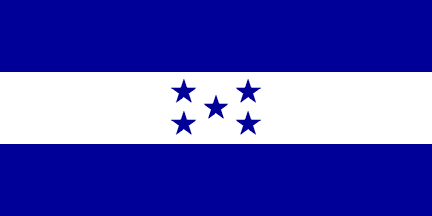
by Željko Heimer, 10 October 2004
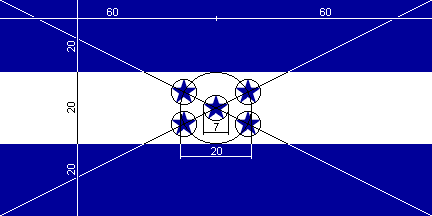
Construction Sheet
by Željko Heimer, 10 October 2004
The Decree of 1933 defined the flag by illustration not by
written construction details. I only have the wording and my
hand-drawn specification based on the original. None
the less the relevant wording is as follows:
Acuardo o. 194 dated 27 September 1933 - "...on the white
stripe, in a circular form, there appears five blue stars in the
manner of the accompanying illustration" (headed
Appendix I).
According to my spec the illustration showed that the stars were
contained within imaginary circles equal to 12% of flag width,
and arranged around a circle equalling one-third of flag
width. It should be noted however, that the 1939
Flaggenbuch (presumably based on the same illustration) shows the
stars of roughly the same size but arranged around a rather
smaller circle.
Christopher Southworth, 8 October 2004
Above is the drawing of the flag of Honduras as prescribed by
the 1933 regulations (abandoned formally in 1949, but in any case
this design was de facto used quite long afterward and in
flagbooks even longer).
Željko Heimer, 10 October 2004




